Nose
Delicate cherry and raspberry
aromas are complicated by dried herb,
anise, and baking spice.
Palate
Soft in texture and
round on the palate, flavors of cherry and
cranberry are joined by tea leaf and an
underlying minerality which slowly give way
to a pure expression of just-ripe red fruit on
the finish.
Growing Conditions
When our Russian River Vineyard was planted in 1997 by Anne Moller-Racke and Joe
Nugent, 10 acres were planted to Dijon clones 115 and 667. In 2008 we decided to
plant 5 more acres on an adjacent plot, this time to Pommard clone. The idea was that
in these slightly more gravelly soils, the Pommard clone would thrive and produce an
elegant, perfumed wine to play off of the rich, powerful dark fruit flavors produced by
the Dijon clones. We named this block of Pommard clone “Ten Oaks” after the ten
majestic trees that border it on two sides.
Harvest
After very cool growing seasons in back to back years (2011 & 2012), the 2013 vintage felt quite warm,
although it was actually close to average for Northern California. Bud break occurred very early thanks
to a warm spring, leading to concerns about an extremely early harvest, but we avoided any heat spikes
throughout the summer, which slowed things down in the vineyard. With all of our vineyards (and
seemingly everyone else’s in Sonoma and Napa) tracking around the same sugar levels, the potential for
too much fruit at once made everyone nervous, but cool weather at just the right times in early and late
September created the spacing we needed. The 2013 calendar year was very dry, but fortunately heavy
rains in November and December of 2012 provided enough moisture in the soil and water for irrigation
to last the growing season. One small rain event on September 21st and 22nd created some worries, but
little rain fell and strong winds dried the vineyards out quickly. Our harvest began at our Russian River
Vineyard on September 2, and wrapped up in Carneros on October 8.
Bottling
Blended and bottled in February, 2015.
Winemaking
Early on the morning of September 2, 2013, we harvested about 2 acres from the Pommard block on the
Winside Vineyard and brought it to the winery where it was hand-sorted and gravity fed to tank. About
15% of the clusters were left whole, as the stems lend the wine an intriguing savory note. Fermentation
began spontaneously after a seven day cold soak. During fermentation the must was pumped over the
cap to ensure contact between the juice and skins, but punchdowns were avoided to prevent
over-extraction. To further limit extraction, the temperature was kept on the lower side. After primary
fermentation the wine was racked to barrel, where it underwent native malolactic fermentation in barrel.
Aging
The finished wine rested on the lees without racking for about 14 months.
Appearance
Medium ruby in color, with a hint of garnet at the rim.







